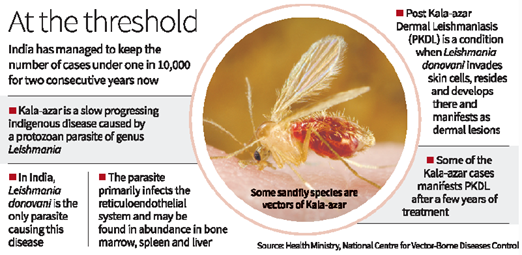TAG: GS-3: SCIENCE & TECHNOLOGY
THE CONTEXT: India is on the verge of eliminating kala-azar as a public health problem, with less than one case per 10,000 people reported for the last two years, necessary for World Health Organisation (WHO) certification.
EXPLANATION:
About the kala-azar:
- Kala-azar is the second deadliest parasitic disease after malaria in India. As per figures released by the Health Ministry India registered 595 cases and four deaths in 2023 and this year it has recorded 339 cases and one death so far.
- Kala-azar, also known as visceral leishmaniasis (VL), is a severe form of leishmaniasis caused by the protozoan parasite Leishmania donovani.
- It is transmitted to humans through the bite of an infected female sandfly, primarily Phlebotomus argentipes in India.
- The disease affects some of the world’s poorest people and is associated with malnutrition, population displacement, poor housing, a weak immune system and lack of financial resources.
- People with HIV and other conditions that weaken their immune system, are more likely to get sick from a Leishmania infection.

Types:
- Visceral leishmaniasisaffects multiple organs and is the most serious disease.
- Cutaneous leishmaniasiscauses skin sores and is the most common form.
- Mucocutaneous Leishmaniasis, which causes skin and mucosal lesions.
Symptoms:
- Initially, leishmania parasites cause skin sores or ulcers at the site of the bite. If the disease progresses, it attacks the immune system.
- Kala azar presents after two to eight months with more generalized symptoms including prolonged fever and weakness. It causes fever, weight loss, spleen and liver enlargement. Left untreated, it can be fatal in 95% of cases.
Treatment:
- Treatment of Kala Azar is done through liposomal AmB – this is the drug of choice for immunocompetent patients.
- There are other treatment options available such as paromomycin, miltefosin and multidrug therapy treatment.
- Vector control is also recommended by the WHO, which means reducing or interrupting the transmission of disease by decreasing the number of sandflies in surroundings through insecticide spray, use of insecticide-treated nets, etc.
Current status in India:
- Cases and deaths: India registered 595 cases and four deaths in 2023. In 2024, the number of cases decreased to 339, with one recorded death so far.
- Eligibility for WHO certification: India could soon become eligible for the elimination certificate if the trend of keeping cases below one per 10,000 people continues for another year.
- If it can maintain the figures for another year India will become eligible to seek the elimination certificate from WHO making it the second country in the world after Bangladesh which in October became the only country to have eliminated Kala-azar, also known as visceral leishmaniasis, as a public health problem.
|
Vulnerable regions: Bihar accounts for over 70% of the total cases, along with Jharkhand, West Bengal, and parts of Uttar Pradesh.
- The WHO validated this status after Bangladesh reported fewer than one case per 10,000
India’s Efforts to Control Kala Azar:
- The Government of India launched a centrally sponsored Kala-azar control program in 1990-91, which was later revised in 2015.
- The program aimed to eliminate Kala-azar by 2023, aligning with the WHO neglected tropical diseases (NTDs) Roadmap goal of 2030.
- The National Vector Borne Disease Control Programme (NVBDCP), 2003 is an umbrella programme for prevention and control of vector borne diseases viz., malaria, lymphatic filariasis, kala azar, and chikungunya.
Recent Efforts:
- Rigorous indoor residual spraying effort aimed at curtailing sandfly breeding sites; application of a special soil to seal crevices in mud walls, preventing sandflies from nesting.
- Pucca houses in KA-affected villages have been constructed under PMAY-G – A total of 25,955 houses in 2017-18 (1371 houses in Bihar & 24584 in Jharkhand).
- Mobilisation of the ASHA (Accredited Social Health Activist) network to ensure completion of treatment for PKDL patients, who require a 12-week course of Miltefosine (an antileishmanial agent).
Source:
Spread the Word
